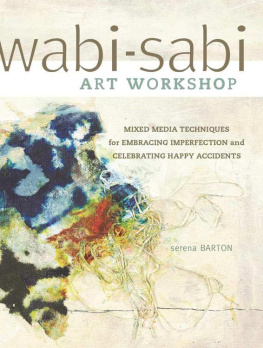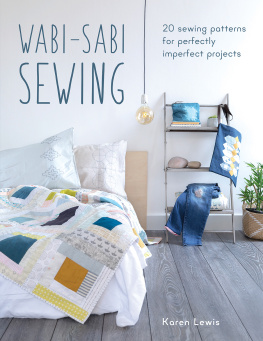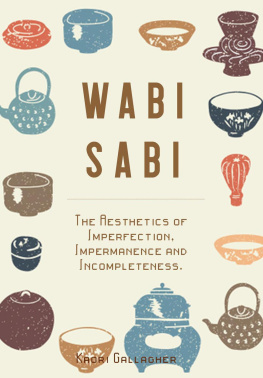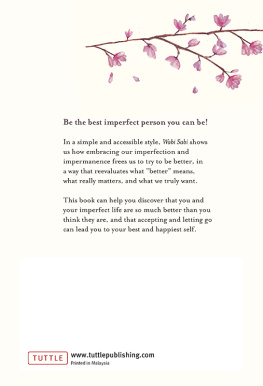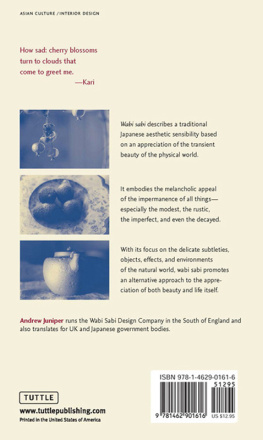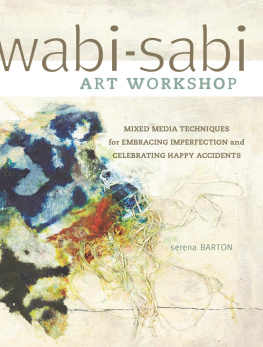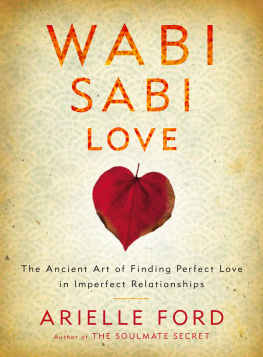Wabi-Sabi Art Workshop
Mixed-Media Techniques for Embracing Imperfection and Celebrating Happy Accidents
Serena Barton

createmixedmedia.com
contents
looking for wabi-sabi and finding it all around you
patina of time: creating the effects of seasoning
strata of time: creating layers of texture
throw in the towel: working with the unexpected
abstracting from the real: the power of suggestion
translucence: creating wabi-sabi in wax
buried treasure: 3-D wax art and other enhancements
ONLY A CHIRPING INSECT
TOLD ME IT WAS NIGHT
THE MOON WAS SO BRIGHT.
~Etsujin
Introduction
Welcome! Im delighted to have you join me on this wabi-sabi adventure. Together well create with inspiration from the world around us as well as inspiration from our feelings, memories and desires.
We all come to painting and mixed-media art via different paths. Heres my story:
I loved to draw and color as a young child. One of my first endeavors was to decorate the butcher paper float that my father attached to my tricycle for a childrens parade when I was four. I covered the paper with mermaids, fairy queens, ballerinas and maybe even a witch. For the parade I was dressed in jeans, a sweater, a halo and wings. Being in the paradet v was a big deal for me. I saw my first parade at age three, and I remember crying because I wanted to be in the parade, not just watch it.
When I was a little older, acting captured my interest. Being onstage was a wonderful cure for my extreme shyness. In a play I could be anyone. As an adult I became a counselor and mother. Over the years I experimented with various crafts, such as weaving, but I was never exact enough for media where precision is important.
In 1995 I took my first trip to Italy and I was overwhelmed by the beauty I saw. The plentiful art, the crumbling surfaces of buildings, the hills of Tuscany and the canals of Venice enchanted me. I vowed then I would return to my roots and learn again to create art.
I found in my art exploration that my strength lay in expressive and intuitive work. I began with acrylic paint, moved to oil paint and fell in love with mixed media. Like many of you, Im not content to work in just one medium. In this book Ive included several of my favorites such as acrylic, re-inker, oil, plaster and encaustic. Use my techniques, media and projects as springboards to creating art with your own unique style and with the color palettes you prefer.
Whether you are a beginner, beginning again or an established artist, my message to you is the same. Experiment, enjoy, keep working, embrace accidents and mistakes and trust yourself. In this book youll learn to delight in adding layers, subtracting elements and allowing yourself to love the process and the result!
Remember, if youre making art, youre in the parade!

CHILDRENS PARADE
Once upon a time

Gallery: DESIRE
Encaustic on wood panel

Gallery: ZEITGEIST
Mixed media on wood panel
Finding Inspiration and Beauty in the Ordinary
When I first heard the term wabi-sabi, the sound of the words intrigued me. I set out to find out what the term meant. After finding some clues in books, photographs and, yes, the Internet, I realized the term refers to a kind of philosophy, aesthetic and feeling I had already internalized. I was excited by this realization and was inspired to begin creating paintings and mixed-media pieces that embodied my understanding of wabi-sabi.
The term wabi-sabi comes from two Japanese words and refers to that which is imperfect, impermanent, aged, humble and authentic. Both nature- and human-made objects may have wabi-sabi qualities. Wabi-sabi is an aesthetic that values the passing of time, the seasoning of time and the elements, the handmade and the simple. Wabi-sabi is a way of being open to emotion and acceptance. Wabi-sabi is a state of mind and a state of feeling. I find this state of being expressed in traditional haiku poetry, which can express a world of seeing, listening, smelling,atiU tasting and feeling in the recording of a single moment.
In these pages, Ill share my understanding and inspiration with you. Together well explore the meaning and beauty in the ordinary objects we see every day. Well honor the humble and the worn, the imperfect and the transitory. Ill give you tools, techniques and ideas that you can use to enter into the essence of wabi-sabi. More than anything, Ill encourage you to work from your heart. When you make wabi-sabi art, you allow the process to unfold and to envelop you in the moment. Wabi-sabi embraces serenity, joy, solitude, surprise and whatever else you may experience in the moment.
When I was in my twenties, an acquaintance who had lived in Japan told me that the Japanese ideal of beauty was a flower just past its prime, a flower beginning to turn brown at the edges of its petals. Back then, this seemed a strange idea to me, but now I understand it better.
We mixed-media artists and art lovers are drawn to objects that speak of the passage of time. We may feel bittersweet emotion as we think of those who lived before us, and we may wonder what their lives were like. We like nature in its wilder states. The wabi-sabi outlook accepts that we are all impermanent on this earth and that the most important thing in life is to be fully present in the moment. We are open to any and all of our emotions in this moment and accept them with serenity.
I am also drawn to the ideal of the handmade and the imperfections that make an object singular and meaningful. My wabi-sabi work is experimental and interactive. Rather than planning out a piece before I create it, I work with the materials and let them guide me. I make a lot of mistakes and have a lot of accidents while Im working. And thats excellent! In this book, I will talk about the beauty of imperfection and some of the wonderful effects of unintended elements. Ill show you ways to redo pieces youve put aside, and Ill let you in on some accidental discoveries that have inspired me to use materials and techniques in new ways.
This book covers how to use your own photographs for inspiration and how to create wabi-sabi texture and color on your piece. Youll start with simple landscape compositions in acrylic and re-inker glaze and end with complex layers of mixed-media elements. Wabi-sabi can embody the less is more aesthetic as well as more is more. In my work I often combine simplicity of composition with complexity of layering. The projects in this book have in common the qualities of asymmetry, a seasoned look and a sense of contemplation.

